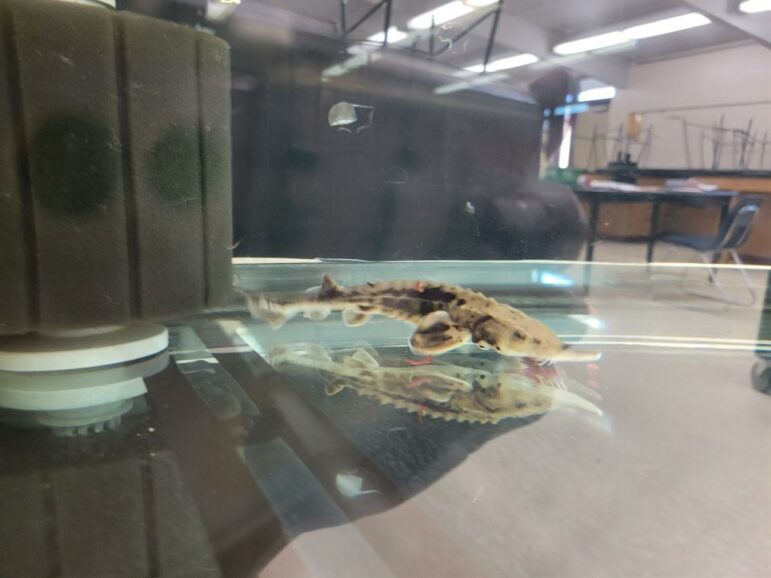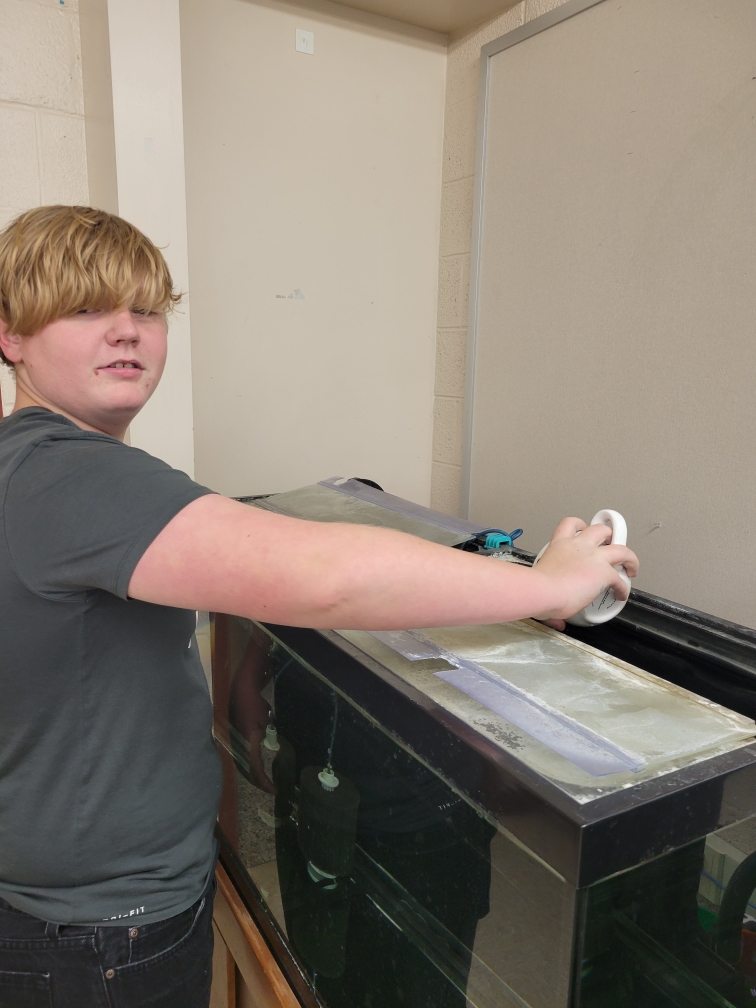
Katie Bryant
Big Randy, the sturgeon in Katie Bryant’s seventh-grade class, is pictured in its tank at LakeVille Middle School. Her class is one of several Michigan science classrooms that incorporate sturgeon into their curriculum, using it to teach children about conservation and natural resources.By JACK ARMSTRONG
Capital News Service
LANSING—Sturgeon can live 50 years or more in rivers and lakes, but the first six months of one sturgeon’s life will be spent in Katie Bryant’s seventh-grade science classroom.
Jay Woiderski recently walked into LakeVille Middle School with a small fish in a plastic bag. He dropped the bag into a 75-gallon tank and waited for the temperature to equalize. Then, he opened the bag and let the fish out.
The fish, Bryant’s class and the children in LakeVille, Genesee County, are participants in the state’s “Sturgeon in the Classroom” program. Schools raise a young sturgeon to teach kids about conservation and environmental stewardship. About 10 schools take part every year.
Also participating this year are Alcona Elementary School, Cheboygan Middle School, Holt High School, Inland Lakes Schools in Indian River, Onaway High School, Quincy Elementary School in Zeeland and St. Lorenz Lutheran School in Frankenmuth.
“The kids really enjoy it,” Bryant said. “It’s a really good example of the harm that has been done to Michigan and the ways that people are going about mitigating the damage.”
Lake sturgeon, the oldest and largest native species in the Great Lakes, are endangered now, but were once abundant in the region. They can live from 50 to 150 years and have been measured at up to 6½ feet.
But overfishing and development decimated their numbers. Only 1% of lake sturgeon’s historical population survives.
“Our sturgeon in the classroom program is basically our big educational outreach,” said Woiderski, the president of Sturgeon for Tomorrow, a nonprofit organization that originated the classroom program.
“The program is meant to educate and hopefully get everybody to fall in love with sturgeon the way I have since I was 4 years old, probably,” Woiderski said.
Sturgeon for Tomorrow distributes one juvenile to each participating school, and the students are responsible for raising it throughout the year.
At LakeVille, Bryant’s 75-gallon tank sits at the front of the classroom. A nearby chiller keeps the water cold and a freezer holds bloodworms for sturgeon food. Bryant’s students are responsible for feeding it and changing its water weekly.
“I’ll teach one kid how to feed the fish, and then that kid has to teach somebody else,” Bryant said.
Bryant teaches about the sturgeon’s anatomy, its place in the ecosystem and the fishing regulations associated with it. The fish is a good ambassador for conservation, she said, and a good indication of a healthy ecosystem.
She also teaches the importance of conserving natural resources and biodiversity.
“The hope is that if these kids tell their parents and those parents tell one other person, we’re letting a lot of people in Michigan know,” she said.
Right now, LakeVille’s sturgeon is smaller than the palm of your hand, but it’ll be around a foot long by the time Bryant’s students release it.
The kids love the program, and they’re “all about feeding the fish and taking care of the fish,” Bryant said.
Students’ reactions to the sturgeon are “absolutely huge,” Woiderski said, comparing it to a kid getting a new kitten.
The previous year, Bryant’s students named their sturgeon “Grimace,” after the fast food giant McDonald’s friendly purple character. Bryant said former students sometimes tell her they miss Grimace.
This school year, her students named their fish “Big Randy.” Randy is more active compared to previous sturgeons, Bryant said.
“They all have different personalities,” she said. “I had one that would just poke the top of the tank.”
“Sometimes they’re really chill and they just stay at the bottom. Sometimes they swim around, get the zoomies and run into the side of the tank,” she said.
Some even disrupt lessons with their activity.
At the end of the school year, the release of the sturgeon becomes a community event. Students invite parents and grandparents as the class releases the fish into Cass River in Frankenmuth, a location free from the dams that interfere with sturgeon spawning.
“Then we walk over to Heritage Park and have a celebration,” Bryant said.
The lake sturgeon is one of 27 species that make up the sturgeon family, which has been around for 200 million years and has been swimming up streams and around lakes since dinosaurs roamed the Earth.
Lake sturgeon are easily identified by their long, flattened snouts and the bony armor that lines their backs, called scutes. They have four whisker-like appendages on the bottom of their snouts called barbels and use them to find food along the bottoms of lakes and rivers.
Near the beginning of commercial Great Lakes fisheries, lake sturgeon were plentiful, but not desirable. They were scrapped or burned as fuel. Later, more commercially viable uses were found – they were harvested for meat and eggs, and their numbers dropped due to overfishing.
In recent times, the lake sturgeon has occupied a Great Lakes cultural niche. In the Cheboygan County community of Indian River, a 32-foot-long steel sturgeon statue sits on a stone outcropping in a patch of grass on the side of the road.
Every year at Black Lake near Cheboygan, hundreds of anglers spread across the ice in hopes of spearing one of six sturgeon allotted for fishing by the Department of Natural Resources. Near the shore in a large canvas tent, Sturgeon for Tomorrow sells sturgeon-themed sweaters, t-shirts, pins and stuffed sturgeons.
Sturgeon for Tomorrow would like to expand the program into Southwest Michigan and the Upper Peninsula.
“The work we’re doing today, I probably won’t live long enough to see the results of,” Woiderski said. “It’s not about me. Originally, yep, I’m going to tell you it was. But I’m a long way from that now.”

Katie Bryant
Seventh-grader Keegan Shrader feeds Big Randy at LakeVille Middle School. Shrader and his classmates are responsible for caring for the fish this school year.